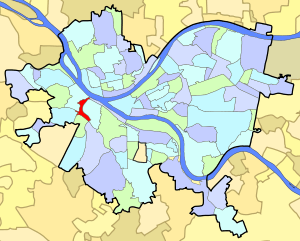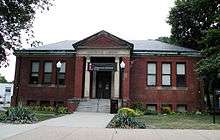West End (Pittsburgh)
| West End West End Valley (formerly Temperanceville) | |
|---|---|
| Neighborhood of Pittsburgh | |
|
The Old Stone Inn located at 434 Greentree Road, possibly circa 1756, may be one of the oldest buildings in the region. | |
 | |
| Coordinates: 40°26′08″N 80°02′06″W / 40.4355°N 80.0351°W | |
| Country | United States |
| State | Pennsylvania |
| County | Allegheny County |
| City | Pittsburgh |
| Area[1] | |
| • Total | 0.2 sq mi (0.5 km2) |
| Population (2010)[1] | |
| • Total | 254 |
| • Density | 1,300/sq mi (490/km2) |
| ZIP Code | 15220 |
West End Village (originally named Temperanceville) is a neighborhood in Pittsburgh, Pennsylvania's west city area. It has a zip code of 15220, and has representation on Pittsburgh City Council by the council member for District 2 (West Neighborhoods).
The neighborhood lies in a small valley south of the Ohio River and less than a mile from downtown Pittsburgh. Temperanceville was founded as a dry town and was annexed to the City of Pittsburgh in 1874.[2] Today it features a business district that has attracted renewed interest as a design district, featuring businesses like the James Gallery, Ceramiche Tiles, Caldwell's, Jacob Evans Kitchen and Bath, and Artifacts, among many others. To support these businesses, the Urban Redevelopment Authority added the West End Village as a Mainstreet Pittsburgh district in 2009.[3] The West End Bridge crosses the Ohio River and connects the neighborhood to the North Side of the city. Carson St. connects it to Station Square and the South Side to the east, and the borough of McKees Rocks to the west.
Region
The term "West End" is also used to refer to the surrounding region, which includes the West End Valley in addition to western neighborhoods Sheraden, Elliott, Windgap, Esplen, Ridgemont, Westwood, Oakwood, East Carnegie, Chartiers City, Fairywood and Crafton Heights. The West End of Pittsburgh is mostly residential, with some industry and a relative paucity of commercial districts in comparison to the rest of the city. The West End has few notable tourist attractions other than the West End Overlook (actually located in Elliott), a small hilltop park in the neighborhood of Elliott that offers a view of the Golden Triangle (Downtown) from downriver (Ohio River).
The term "West End" is often mistakenly used to refer to the area southwest of the Ohio River. Upon annexation, the City of Pittsburgh renamed the Borough of Temperanceville as West End; Temperanceville was its own entity (incorporated 1860[4]) on the valley floor through which Saw Mill Run flows toward the Ohio River, between the Coal Hill end of Mt. Washington upriver, and River Hill downriver (site of the Elliott bluff lookout, a.k.a. the West End Overlook (c.1961)/West End-Elliott Overlook (c.2004) the top of which is in a neighborhood corner of the (annexed) community of Elliott.
The Pittsburgh southwest communities are essentially well-located residential areas, supported by local businesses, and with ready access to the rest of the City and surrounding areas and highway systems. But, over the past 30+ years and continuing, the West End (Temperanceville) has suffered much demolition of its indigenous residential architecture, and removal of most of its tenant units from the rental market, displacing a once substantial low-middle-fixed income multicultural population, in favor of many unsuccessful attempts to attract business.
The West End, despite its demolitions and depopulation, and especially its sibling, still-affordable 100+ year old residential Elliott, are ideal family residential locations with respect to the City and the surrounding areas.
Despite demolitions and failure to reuse so many indigenous dwellings, and recent demolition of half a block on South Main St., the West End has three designated historic landmark buildings (among many others not designated) the German (now Jerusalem Baptist) Church on Steuben St. at Sanctus St., the 1899 Carnegie Branch Library on Neptune St. (spoken for by Andrew Carnegie himself, 2nd in the Pittsburgh Carnegie system, home of the first Library Story Hour anywhere, and the most recently recognized the Old Stone Tavern on Greentree Rd. at Woodville Ave. --which may turn out to pre-date the Fort Pitt Blockhouse as the oldest building west of the Alleghenies.
In Elliott, the bluff/"overlook", once one of the most-visited sites in Allegheny County has been less so since 2004 when a $2.5+ million improvement eliminated historically-available vehicle access to the bluff-top, thereby impacting all-weather all-season visiting, and altering the once truly unique ambiance that came with the city-view, recognized world-wide, of the 3 rivers (Allegheny-Monogahela-Ohio.) Still, it is something to experience, especially at night when the concrete-ization of the near northside is not so blatant. Elliott and Crafton Heights also share the still open presence of the Obey House (1823) once a true Road House on the Steubenville Pike (the land route West from Pittsburgh.)
Highways
West End Bypass / Banksville Circle
The West End Bypass is a 1.1 stretch of highway (designated as Saw Mill Run Blvd/U.S. 19, PA 51), running from the West End exit interchange on the Penn Lincoln Parkway (Exit 69C) to the West End Circle. When this bypass opened in 1951, its South Hills connector was the Banksville Circle, a predecessor thoroughfare to the Parkway and Fort Pitt Tunnels. This circle provided direct access to the West End via Woodville Avenue. It was removed by the late 1950s with the construction of the Penn Lincoln Parkway. However, the Woodville Avenue connector still exists, accessible via Parkway Exit 69C and Carnegie/Airport exit from the West End Bypass.
West End Circle
The West End Circle is the circumference of traffic south of the West End Bridge, brought together by the West End Bypass (see above), South Main Street (PA Route 60--southern terminus), Steuben Street, and West Carson Street (PA 51/PA 837--northern terminus). The Norfolk Southern railway overpass (formerly Pennsylvania Railroad) runs straight through the circle, and Wheeling & Lake Erie Railroad ran across Steuben Street, across a trestle and alongside the West End Bypass.
A complete reconfiguration of the West End Circle started in October 2007, including new bridges and new improved connectors. A new underpass was dug under the Norfolk Southern Railroad for straight access to the West End Bridge northbound and West End Bypass southbound. The West End segment of the Wheeling and Lake Erie Railroad has been discontinued as the track on Steuben Street and trestle over South Main Street have been removed.[5] The project was completed in October 2010.[6]
See also
Gallery
 West End Branch of the Carnegie Library of Pittsburgh, built circa 1890, located at 47 Wabash Street.
West End Branch of the Carnegie Library of Pittsburgh, built circa 1890, located at 47 Wabash Street. West End Bridge, built from 1930 to 1932, crosses the Ohio River and connects the West End to the Chateau neighborhood in the North Side of the city.
West End Bridge, built from 1930 to 1932, crosses the Ohio River and connects the West End to the Chateau neighborhood in the North Side of the city.
References
- 1 2 "PGHSNAP 2010 Raw Census Data by Neighborhood". Pittsburgh Department of City Planning PGHSNAP Utility. 2012. Retrieved 28 June 2013. External link in
|publisher=(help) - ↑ Bloom, Albert W. (Jan 14, 1953). "Pittsburgh today made up of many villages". Pittsburgh Post-Gazette. p. 23. Retrieved 2 December 2015.
- ↑ http://www.ura.org/business_owners/mainstreets.php
- ↑ https://books.google.com/books?id=lR43AQAAMAAJ&pg=SA7-PA57&lpg=SA7-PA57&dq=Temperanceville+%22incorporated+as+a+borough%22&source=bl&ots=xPI6M7FdON&sig=jHpnfj1oXTUAp0q_W6MJr4Nmc_g&hl=en&sa=X&ved=0ahUKEwjwodSU3OTNAhUEz2MKHe9ADyMQ6AEIHjAA#v=onepage&q=Temperanceville%20%22incorporated%20as%20a%20borough%22&f=false
- ↑ http://www.post-gazette.com/breaking/2012/01/11/West-End-railroad-underpass-that-snarled-traffic-to-come-down/stories/201201110176
- ↑ Schmitz, Jon (2011-06-07). "West End Circle Redesign Wins Award". Pittsburgh Post-Gazette. Retrieved 2011-10-13.
External links
| Wikimedia Commons has media related to West End (Pittsburgh). |
